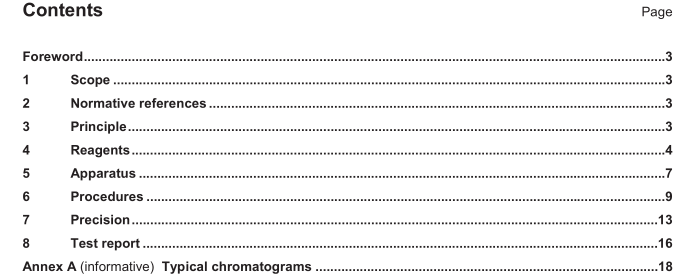EN 14123:2007 – Foodstuffs – Determination of aflatoxin B 1 and the sum of aflatoxin B 1 , B 2 , G 1 and G 2 in hazelnuts, peanuts, pistachios, figs, and paprika powder – High performance liquid chromatographic method with post-column derivatisation and immunoaffinity column cleanup

1 Scope This European Standard is applicable to the determination of aflatoxins B 1 , B 2 , G 1 and G 2 in hazelnuts, figs, pistachios, peanuts and paprika powder. The limit of quantification of the method is 0,8 ng/g for each aflatoxin or better (value derived from in-house and collaborative study), depending on the equipment used.
2 Normative references The following referenced documents are indispensable for the application of this document. For dated references, only the edition cited applies. For undated references, the latest edition of the referenced document (including any amendments) applies. EN ISO 3696, Water for analytical laboratory use – Specification and test methods (ISO 3696:1987) 3 Principle A test portion is either extracted with a solvent solution (methanol/water) or the solvent solution plus hexane (or cyclohexane).
The sample extract is filtered, diluted with phosphate buffered saline (PBS) and applied to an immunoaffinity column (IAC) containing antibodies specific to aflatoxins B 1 , B 2 , G 1 and G 2 . The aflatoxins are eluted from the immunoaffinity column with methanol. Aflatoxins are quantified by reverse-phase high performance liquid chromatography (RP-HPLC) with post-column derivatization (PCD) involving bromination followed by fluorescence detection. The PCD is achieved with either electrochemically generated bromine or with pyridinium hydrobromide perbromide (PBPB).
4 Reagents
4.1 General
Use only reagents of recognized analytical grade and water complying with grade 3 of EN ISO 3696, unless otherwise specified.
4.2 Water, complying with grade 1 of EN ISO 3696
4.3 Phosphate buffered saline (PBS), pH = 7,4
Dissolve 0,20 g of potassium chloride, 0,20 g of potassium dihydrogen phosphate, 1,16 g of disodium hydrogen orthophosphate (or 2,92 g of hydrogenphosphate·12 H 2 0) and 8,00 g of sodium chloride in 0,9 l of water. After dissolution, adjust the pH to 7,4 with HCl (0,1 mol/l) or NaOH (0,1 mol/l) as appropriate. Dilute to 1 l with water.
Commercially available phosphate buffered saline tablets with equivalent properties may be used.
4.4 Sodium chloride (NaCl)
4.5 Pyridinium hydrobromide perbromide (PBPB), [CAS: 39416-48-3]
4.6 Potassium bromide (KBr)
4.7 Acetonitrile, HPLC grade
4.8 Methanol, HPLC grade
4.9 Methanol, p.a. grade
4.10 Toluene
4.11 Extraction solvent mixture of methanol and water
Mix 8 parts per volume of methanol (4.9) with 2 parts per volume of water.
4.12 n-Hexane, cyclohexane, p.a. grade
4.13 Nitric acid, c(HNO 3 ) = 4 mol/l
Dilute 28 ml of nitric acid (volume fraction is 65 %), or 26 ml of nitric acid (volume fraction is 70 %) with water to a final volume of 100 ml.
EN 14123:2007 – Foodstuffs – Determination of aflatoxin B 1 and the sum of aflatoxin B 1 , B 2 , G 1 and G 2 in hazelnuts, peanuts, pistachios, figs, and paprika powder – High performance liquid chromatographic method with post-column derivatisation and immunoaffinity column cleanup